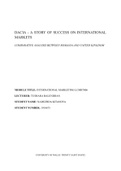DACIA - A STORY OF SUCCESS ON INTERNATIONAL
MARKETS
COMPARATIVE ANALYSIS BETWEEN ROMANIA AND UNITED KINGDOM
MODULE TITLE: INTERNATIONAL MARKETING LCMB7006
LECTURER: TUSHARA BALENDRAN
STUDENT NAME: NADEZHDA KITANOVA
STUDENT NUMBER: 1918675
UNIVERSITY OF WALES TRINITY SAINT DAVID
,1. INTRODUCTION
Yet just a machine, the purchase of a car had become more an emotional purchase, than a
rational one. The automotive industry is known for its complex business relationships,
industry rivalry and dynamic environment. This report examines how a very “rational” brand,
with the main scope of providing nothing, but the “bare necessities”, managed to succeed in
the competitive UK market. The first part of this report discusses the company’s macro and
microenvironment by comparing the domestic and the UK market. Chapter 7 and 8 focus on
Dacia’s marketing strategy and its implementation on local and international markets. The
second part of this report discusses future opportunities for Dacia and recommendations for
strategic improvement.
2. COMPANY BACKGROUND AND HIGHLIGHTS
Automobile Dacia is a Romanian car manufacturer, founded in 1966.
Assembly of the Dacia 1300 (known as “Romanian Renault 12”) began in 1969 and
continued five decades, making Dacia not only a brand for Romanian people but a symbol.
In 1999, Renault Group took a 51% stake in state-owned Dacia, which rose to 99.3% in 2003.
The new brand intended to focus on an entirely new category, addressing emerging markets.
Its mission is to produce modern and robust cars, which are affordable.
Nearly €500m were spent modernising the Pitesti factory to meet the highest international
standards. In a year's time, the first key model, Dacia Logan, broke all production records and
became one of the top-selling cars in Europe and Russia. Dacia cars are sold in Europe,
Russia, Asia, South America and North Africa, but in many emerging markets, they are
commercialized under Renault or other local brands. After the undeniable success of Logan,
Dacia soon turned its attention to new segments of the market. Following the global trend
towards SUV vehicles, Dacia Duster was launched. The model, marketed under both Dacia
and Renault brands, became a huge success on the European and Russian market. In the UK
alone, Duster has received prestigious awards from Parkers, Auto Trader, The Sun and
Whatcar? as well as 5-star reviews from its customers. Despite being a huge global success,
the Dacia brand had not been commercialised in the UK until 2012. Dacia achieved the
highest first-year market share of any brand in UK history, selling more than 100 000 cars in
4 years. Dacia UK is the first country to introduce its eCommerce solution, "Dacia Buy
Online" - a platform that allows every stage of the purchase to be made online; including
finance, part-exchange and service and warranty packages, plus home delivery. In 2020, the
company announced that it would be launching its first electric car, Dacia Spring.
, 3. MACROENVIRONMENTAL ANALYSIS OF DACIA IN ROMANIA AND THE
UK
The macroenvironment consists of all external forces which might influence the company and
create opportunities and threats.
Source: https://www.business-to-you.com
● POLITICAL FACTORS
IN ROMANIA - FAVOURABLE
Dacia is a local brand, contributing 3% to the
Romanian GDP. At a national level, the automobile
sector's contribution to the economy constitutes about
14% of GDP in 2018 and 27% of exports. The
automotive industry is not only a driver of growth and
exports but also a good and stable source of earnings for
almost a quarter of a million Romanians working in the industry. “We are not just talking
about the two brands that are produced in Romania, Dacia and Ford, but about 600
companies involved in the horizontal industry, "said the Economy Minister at the Auto
Industry Forum 2019 in Craiova. The government stressed that the electrification of the
Romanian car park is a priority, as well connectivity, autonomous technology and the
digitization production chain will certainly bring fundamental changes to the way the entire
automotive ecosystem works, but uncertainties arise in the medium term and are about what
will happen in the next 10-15 years, especially as regards the current level of employment in
the automotive industry. The Government has launched a funding programme to encourage
the shift to electric vehicles. The car scrappage program, also known as “Rabla”, will be
launched at the Ford factor as well. For 2020, the Government has earmarked the largest
budget so far for both the classic car scrappage program and for the program aimed at
stimulating the sales of electric vehicles (“Rabla Plus”). Dacia already announced launching
its first electric car, Dacia Spring. Although regulations on carbon emissions are limiting the
car manufacturer, it may be seen as an opportunity for Dacia to enter a new market segment.
The government already announced that it will prohibit high and strict environment taxes that
would limit the acquisition of used cars and the introduction of dedicated lanes for public
transport vehicles and electric cars. Romania’s National Plan for Energy and Climate
Change (PNIESC) covers the option of a ban on the registration of cars with a pollution
standard below Euro 5. Dacia has partnered in the past with the government on state projects
for car fleets destined to public institutions.





